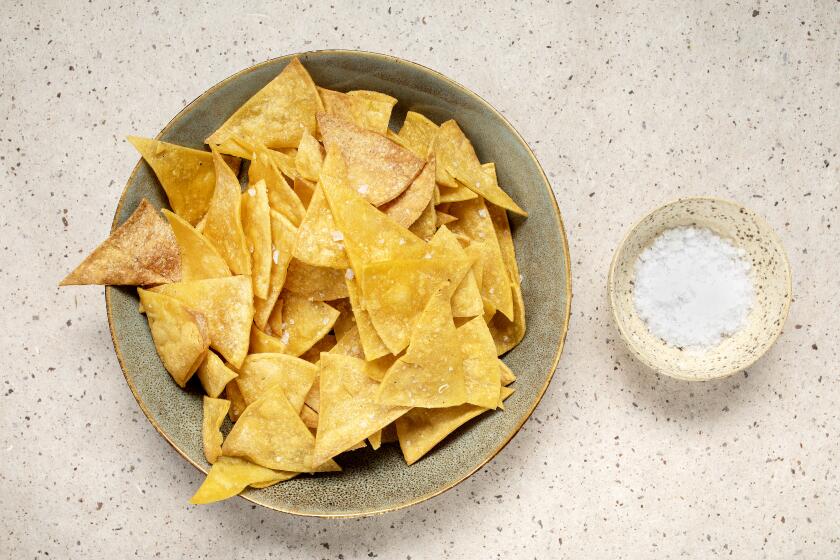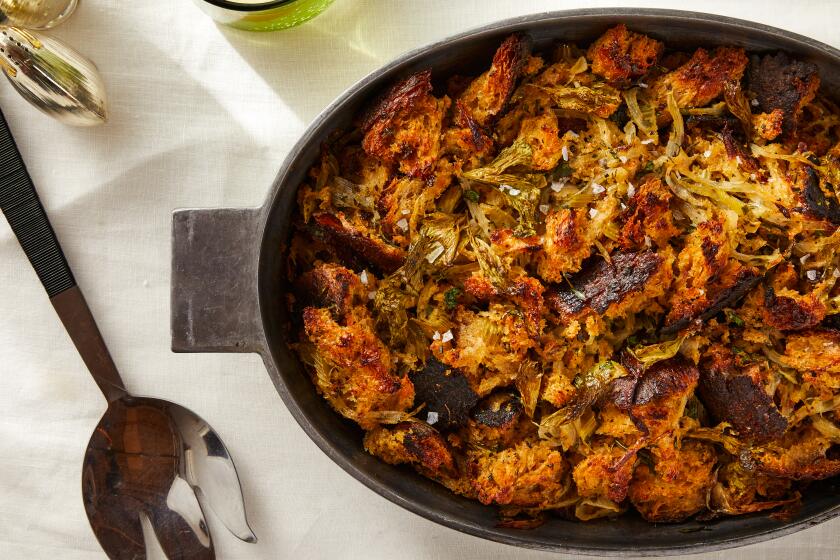Intertwined rosemary and black pepper breads
Thanksgiving, like so many of humankind’s rituals, celebrates transformation, and the golden brown color of its centerpiece food -- glistening roast turkey -- symbolizes not only the transformation of the seasons, but the turning of strangers into friends, pilgrims into homebodies, anecdote into myth.
In the golden brown colors of Thanksgiving, most of all, the transformative power of cooking finds full expression.
The rich, royally festive color of the bird as it’s paraded to the table is a testimony to our joy in turning the stuff of everyday survival into a holiday pleasure. The alchemy of flambeed Cognac brings a deep brandy-brown to the turkey pan sauce. The colors of Thanksgiving breads -- a deep auburn-tinged loaf of brown-butter pecan bread or the ale-colored braids of yeast braid made into a wreath -- speak of the ancient mystery of flour and leavening transmuted.
And the gold and brown gleanings of the woodland and the pantry -- mushrooms, nuts and bread -- are reconfigured into dishes that play subtle shades of brown against each other (such as stuffing) and into haute side dishes such as a savory bread pudding studded with chanterelles the color of Southern California’s autumn-golden hillsides. The seemingly subdued palette of the Thanksgiving plate is of course made up of a range of nuanced hues. Mushroom-brown, walnut-brown, wheat-gold brown: It’s a minimalist’s rainbow.
So let’s not take the browns of Thanksgiving for granted or mistakenly dismiss them as dull. Turn the heat up on the turkey at the end of roasting to burnish the skin; brush the rosemary and black-pepper breads with oil to deepen the color. Carefully caramelize those golden chanterelles for the savory bread pudding to highlight their glow. Uncovering a mushroom-walnut stuffing for a final few minutes of baking allows it to finish with a golden, slightly crisp crown. And browning the butter for the pecan bread gives the sweet slices added depth, not only of flavor, but of visual appeal.
In a large mixing bowl, stir together 2 cups warm water (120 to 130 degrees), 1 package yeast, 1 teaspoon sugar and 1 cup flour. Let sit 15 minutes, until it bubbles. (If the yeast doesn’t bubble, start over with new yeast.)
With a wooden spoon or your hands, mix in 2 tablespoons olive oil, one-fourth cup wheat germ, 1 tablespoon salt, the rosemary and 3 cups flour. Gradually add up to 1 1/2 cups more flour, if needed, until the dough is well-combined and forms a loose ball.
Turn the dough onto a floured board or table and knead it adding more of the remaining flour as needed to prevent stickiness and taking care that the dough does not get too dry. Knead for about 10 minutes, until elastic; when the dough springs back when you poke it with your finger, you’re done kneading.
Shape the dough into a round and put it into a bowl coated with about one-half teaspoon olive oil (turn dough to coat the surface). Cover the bowl with plastic and let the dough rise for about 1 1/2 hours.
Repeat steps 1 to 4, using the black pepper instead of the rosemary.
When the rosemary dough has risen, punch it down and divide it into three pieces. Roll the dough back and forth gently with your hands, forming a long snake. Let the dough rest for a few minutes, then roll again and allow to rest. Repeat the roll and rest procedure 3 or 4 times with each of the 3 portions of dough until each “snake” is about 32 inches long.
Repeat step 6 with the black pepper dough.
When the rosemary and black pepper doughs are each formed into three snakes of dough, wrap the round wooden bottom of the cheese box in aluminum foil, lightly oil the foil and place in the center of a large, oiled double-sheet pan. Place the three rosemary snakes on a lightly floured surface and press one set of ends together. Braid the three snakes of dough, keeping them as uniform in length as possible. Place the braid loosely around the foil-wrapped cheese-box bottom to form a circle. Trim the end of the braid on a diagonal so that it will easily attach to the second braid.
Braid together the three snakes of black pepper dough, trimming the front end of this braid so it will easily attach to the end of the rosemary braid. Wrap this braid loosely around the circle of the rosemary braid, continuing where the first left off. Press the ends under the entire circle when you’ve finished. Make sure the braids are wrapped fairly loosely, as the dough will rise before and during baking.
Cover the dough with plastic wrap and let rest for 30 minutes; meanwhile, heat the oven to 450 degrees. Lightly brush the bread with oil. Bake until golden brown, about 50 minutes to 1 hour, rotating the pan after 30 minutes.
Cool the bread slightly, then carefully remove the foil-wrapped disc and place the wheel of cheese into the center hole. Let rest for about 10 minutes, so the cheese warms and the bread cools and settles. Slice the bread and serve on a platter or cutting board while still warm.
Get our Cooking newsletter.
Your roundup of inspiring recipes and kitchen tricks.
You may occasionally receive promotional content from the Los Angeles Times.















